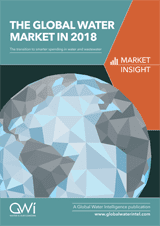Big Data, Sludge and Privatisation: Outlook for Water Until 2022

The deployment of smart systems, big-data technologies, and decentralised solutions for water treatment is expected to grow in the next five years as ageing infrastructure, leakage management, and intelligent sewer networks rise up the utility agenda. At the same time, markets are opening up to private sector investment, according to an updated market insight report for the water industry, bringing great opportunities for players to gain access to new markets.
The global water treatment and distribution market is estimated to be worth approximately $715 billion in 2017. The Global Water Market in 2018, a new market report by Global Water Intelligence pinpoints the most important changes in the water market that will shape business strategy for 2018-2022.
“The biggest adjustment is in the US, where there has been a considerable – and unexpected – fall-off in investment, although the BRIC nations have also been disappointing, but for different reasons. Europe is recovering, but the overall trend is sideways.” commented Christopher Gasson, GWI Publisher.
In the US market the report shows that services for managing existing assets, including network pipe rehabilitation, remain resilient whilst the roll-out of AMI-enabled meters continues, and is now reaching smaller cities. Spending on wastewater treatment is expected to grow at 4.7% with investments in reuse solutions called upon to mitigate the effects of drought, and utilities continue to diverse their water resource portfolios.
From Peru’s $16 billion programme to achieve universal urban wastewater coverage to India’s Ganges clean-up, countries are expanding coverage of wastewater treatment, and looking to the private sector for finance and expertise. This, together with new regulations and tightening standards for WWTP effluent, is driving a market growing at 8% a year.
Anaerobic digestion, sludge pre-treatment, and nutrient recovery have experienced are also big winners, growth in investment of 6.5%. Countries which have achieved adequate wastewater treatment coverage are now focusing on the sludge produced and how it can be disposed of safely. China plans to treat 90% of its sludge to a higher new standard, while legislation passed in Germany banning land-spreading and promoting phosphorus recovery provides a boost to the market.
There are opportunities for international players to get into countries previously closed to private investment as Saudi Arabia, Japan, and Peru make regulatory changes aimed at attracting private finance.
According to the report, spending in the data analysis market is expected to grow at 12% over the next five years. The research shows that there are huge opportunities for smart and, digital solutions as utilities strive to gather more useful data about their networks, and to use it as part of more intelligent decision-making processes to aid greater operational efficiency and flexibility.
In addition, desires for greater cost control, system flexibility and higher speed of deployment are driving a shift away from infrastructure-heavy centralised systems towards decentralised and pre-engineered treatment solutions.
Meanwhile, in the industrial markets there has been growth in US tight oil production driving demand for water treatment and management services; mining continues to expand in water restricted areas, and addressing killer particles from water to prevent disruption to semiconductor production are all pushing investment in treatment technologies.
For further information and to order the report visit www.globalwaterintel.com/gwi/gwm18


